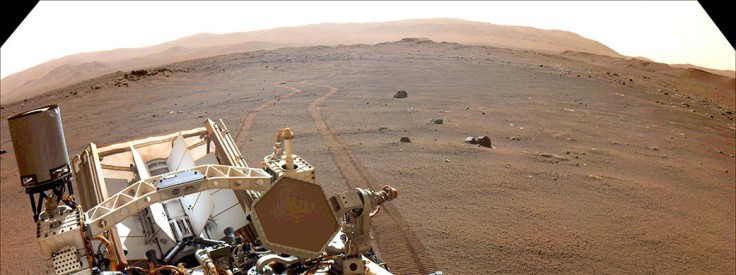The Perseverance rover looks back and captures a photo of its trails on the red planet.
NASA's Perseverance rover, on March 17, is seen looking back on its tracks on its 381st Martian day. The Perseverance rover is part of NASA's Mars 2020 mission launched on July 30, 2020 and landed on Mars on Feb. 18, 2021.

NASA Perseverance Rover Pictures
NASA's Perseverance rover is equipped with instruments and technology that will aid in the preparation of future human missions to the Moon and Mars, searching for signs of ancient life and signs of past microbial life on the planets.
According to NASA, with the help of artificial intelligence (AI) NASA's Perseverance rover is attempting to cover more ground in a single month than any other rover has done before. The Perseverance rover will have to navigate on its own journey ahead, as sandpits, craters, and fields of sharp rocks await.
At the time of the photo, Perseverance is on its way to an ancient river delta within Jezero Crater, where a lake existed billions of years ago. It would be the end of the 3-mile (5-kilometer) journey which began on March 14, 2022.
Researchers and scientists aimed for Perseverance to head to the delta since it is one of the best places on Mars for the rover to look for signs of microscopic life that may have existed in the past. This NASA rover is also well known for collecting various samples of rocks on the red planet to bring along in its return to Earth, using a drill on the end of its robotic arm and the complex sample collection system in its belly.
According to NASA, Perseverance's project scientist Ken Farley of Caltech explained, "The delta is so important that we've actually decided to minimize science activities and focus on driving to get there more quickly."
Farley added, "We'll be taking lots of images of the delta during that drive. The closer we get, the more impressive those images will be."
Read Also: 10 Things to Know About the Curiosity Rover
Tech Behind the Camera
The Perseverance rover is capable of taking images like this as NASA designed the rover to be equipped with enhanced engineering cameras for driving.
NASA's Perseverance rover has three different types of cameras: Hazard Avoidance Cameras (HazCams), Navigation Cameras (Navcams), and CacheCam.
Perseverance uses numerous new generations of engineering cameras that improve on its capabilities beyond the previous Mars rover cameras. NASA designed this rover to include the most advanced and well-engineered cameras to provide more accuracy about what Mars is like.
The enhanced engineering cameras for driving assist human operators on Earth in driving the rover more precisely and accurately targeting the movements of the arm, drill, and other Perseverance rover tools as they approach their targets on the surface of the planet.
The installed cameras have a much better view of the rover itself thanks to the much wider field of view provided. The cameras are also designed to accomplish the important task of checking the health of various rover parts and measuring the amount of dust and sand accumulated.
It is also possible for the new cameras to take pictures while the rover is in motion.
Perseverance Rover
The Perseverance rover's mission on Mars has as one of its primary goals the study of astrobiology, which includes the search for signs of ancient microbial life.
According to Jet Propulsion Laboratory, the Perseverance rover will help the scientists distinguish the planet's geology and past climate, paving the way for human exploration of the Red Planet. It will also be the first mission to collect and store Martian rock and regolith (broken rock and dust), which will pave the way for future missions to the planet.
Related Article: Life on Mars? NASA Discovers Abundant Water Source In The Red Planet









